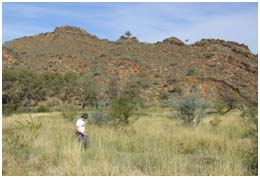CRC60074: Smut Fungi - PhD
This project discovered whether Australian smuts represent a monophyletic group and what ecological factors shaped the diversity of smut fungi in Australia. It also researched whether the evolution of host plants drove the evolution of the smut fungi. It also looked at whether there are molecular loci that allow for nano-scale diagnostic techniques to distinguish smut species and if there are any morphological synapomorphies within smut fungi that will allow them to be split into clear taxonomic groups.
What is the biosecurity problem?
The biodiversity of smut fungi is immense. Vast numbers of cryptic and intriguing smuts occur naturally in undisturbed ecosystems. Smuts occupy many ecological niches and a close relative, the dandruff fungus Malasezzia, even infects animals. Grasses including crops such as wheat, sugarcane, rice, maize and sorghum are all susceptible to smut infection. Diseased plants become infertile as their flowers or seeds are substituted with masses of black, powdery spores. For some cereal grains, entire harvests can become near worthless with the presence of smut spores. It has been estimated that the introduction of wheat smut (Karnal bunt caused by Tilletia indica) to Australia would cause a $A.1.3 billion sway in the economy through a loss of wheat exports, new import costs and job redundancies.
Over 1,500 smut species are known and we are on the verge of understanding the evolution and resolving the taxonomic issues within the group. Australian smut fungi have been comprehensively qualified and their identification has been revolutionized by an interactive, computerized key (Lucid). However, there is some turmoil within the classification of smut fungi as some genera/groups (in particular the Ustilago/Sporisorium/Macalpinomyces complex) overlap causing confusion with species placement. This is problematic as people refer to the same organism by different names. Phylogenetic analysis of morphology, biogeography and molecular loci may indicate how smut fungi evolved and reveal a more accurate classification system.
The main outputs of this project were to:
- revise smut taxonomy (Ustilago/Sporisorium/Macalpinomyces complex) in a systematic framework
- investigate the reasons for character evolution in smut fungi
- determine the historical biogeography and diversification of Australian smuts
- identify economically important smuts through the nanobead molecular diagnostic platform
The diagnostic tools produced for smut fungi will be a model for the creation and application of nanobead diagnostics for other organisms.
Who are the end users of this research?
AQIS and other quarantine organisations, mycologists, systematists.

Publications for this project
STUDENT

Mr Alistair McTaggart
Student CRC60074: Smut Fungi - PhD
alistair.mctaggart@deedi.qld.gov.au
Phone: 07 3896 9598
Read More
PROJECT DETAILS
Complete
Supervisor
Dr Tanya Scharaschkin and Dr James Smith (QUT) and Dr Andrew Geering (QDPI&F)
Supervising Institution
Queensland University of Technology
Term
January 2008 – December 2010

